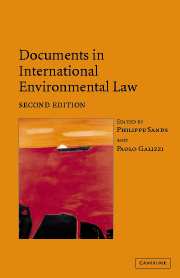Book contents
- Frontmatter
- Contents
- Preface
- PART I General instruments
- PART II Atmosphere
- PART III Oceans: global
- PART IIIB Oceans: regional
- PART IV Freshwater resources
- PART V Biodiversity
- PART VIA Hazardous substances and activities: nuclear
- PART VIB Hazardous substances and activities: pesticides
- PART VIC Hazardous substances and activities: waste
- 28 Convention on the Control of Transboundary Movements of Hazardous Wastes and Their Disposal, 22 March 1989
- 28A Decision III/1 of the Conference of the Parties (Amendment to the Basel Convention), 22 September 1995 (the ‘Basel Ban’)
- 28B Protocol on Liability and Compensation for Damage Resulting from Transboundary Movements of Hazardous Wastes and Their Disposal, 10 December 1999
- 29 Convention on the Ban of the Import into Africa and the Control of Transboundary Movement and Management of Hazardous Wastes within Africa, 29 January 1991
- 30 Code of Practice on the International Transboundary Movement of Radioactive Waste, 21 September 1990
- PART VII Human rights and the environment
- PART VIII War and the environment
- PART IX Trade and the environment
- PART X Environmental impact assessment and access to information
- PART XI Liability for environmental damage and breaches of environmental obligations
- PART XII The Antarctic
28B - Protocol on Liability and Compensation for Damage Resulting from Transboundary Movements of Hazardous Wastes and Their Disposal, 10 December 1999
Published online by Cambridge University Press: 05 June 2012
- Frontmatter
- Contents
- Preface
- PART I General instruments
- PART II Atmosphere
- PART III Oceans: global
- PART IIIB Oceans: regional
- PART IV Freshwater resources
- PART V Biodiversity
- PART VIA Hazardous substances and activities: nuclear
- PART VIB Hazardous substances and activities: pesticides
- PART VIC Hazardous substances and activities: waste
- 28 Convention on the Control of Transboundary Movements of Hazardous Wastes and Their Disposal, 22 March 1989
- 28A Decision III/1 of the Conference of the Parties (Amendment to the Basel Convention), 22 September 1995 (the ‘Basel Ban’)
- 28B Protocol on Liability and Compensation for Damage Resulting from Transboundary Movements of Hazardous Wastes and Their Disposal, 10 December 1999
- 29 Convention on the Ban of the Import into Africa and the Control of Transboundary Movement and Management of Hazardous Wastes within Africa, 29 January 1991
- 30 Code of Practice on the International Transboundary Movement of Radioactive Waste, 21 September 1990
- PART VII Human rights and the environment
- PART VIII War and the environment
- PART IX Trade and the environment
- PART X Environmental impact assessment and access to information
- PART XI Liability for environmental damage and breaches of environmental obligations
- PART XII The Antarctic
Summary
Editorial note
In 1999, pursuant to Article 12 of the 1989 Basel Convention, parties adopted the Protocol on Liability and Compensation for Damage Resulting from Transboundary Movements of Hazardous Wastes and Their Disposal. The Protocol will establish a comprehensive regime for liability and for adequate and prompt compensation for damage (including damage to persons and property and loss of income deriving from an economic interest in the environment, costs of measures reinstating the impaired environment, and preventive measures (Article 1)). Any person who is in operational control of the wastes must take all reasonable measures to mitigate damage arising from an incident (Article 6).
The Protocol applies to damage due to an incident occurring during a transboundary movement, including illegal traffic and in respect of re-import, ‘from the point where the wastes are loaded on the means of transport in an area under the national jurisdiction of the state of export’ (Article 3(1) and (4)). Its application is subject to certain other exclusions (Article 3(6)(a) and (b) and (7) and (8)). It covers all damage suffered in an area under the national jurisdiction of a party, but only damage to persons and property and preventive measures in areas beyond national jurisdiction, and provides particular rules where the state of import, but not the state of export, is a party to the Protocol (Article 3(3)(a), (b) and (c)). Special provision is made for damage to states of transit (Article 3(3)(d) and Annex A).
- Type
- Chapter
- Information
- Documents in International Environmental Law , pp. 918 - 935Publisher: Cambridge University PressPrint publication year: 2004
- 1
- Cited by



